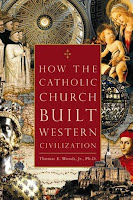How the Catholic Church Built Western Civilization by Thomas E. Woods, Jr.
The modern cultural reputation of the Catholic Church is negative. Recent scandals like the coverups of priestly sexual abuse add to historical complaints about the treatment of Galileo, the Jews, Native Americans, and so-called witches. Such a focus leaves out a lot of things the Catholic Church has done and continues to do. This book argues that core principles and features of Western civilizations were created and refined by the Catholic Church.
It's fairly common to read about the preservation of knowledge and classical literature by the European monks in the chaos after the fall of the Roman Empire. Less acknowledged is the institution of the university system, where information (along with professors and students) flowed freely between school in England, France, Germany, Italy, etc. Master's degrees and license to teach granted scholars status and mobility. Any topic could be discussed and students were expected to argue both sides of an issue, enabling them to have better discernment of the truth. Systematizing and rationalizing knowledge had many benefits. One was the Scientific Revolution, which requires an assumption of a rationally-ordered universe that can be known through observation and reflection.
Much less well known is the Church's contributions in the field of law. In the twelfth century, Church rules and information were brought together from various sources (the Bible, Church Fathers, papal writings, etc.) and systematized into Canon Law. European nations adopted this model, moving away from using local customs and trials by fire or combat (which don't show the truth or the guilt in a situation). Sixteenth century clergy argued about the Native Americans and what rights they had. Did Conquistadors have the right to impose religion and government on inhabitants of the New World? The foundation of international law and human rights began at this time as the humanity of the people living in the Americas was recognized if not respected.
This development is founded on the key principle introduced by the Catholic Church. All human life is sacred, deserving respect and care. In the classical world, the sick and injured were considered expendable. No one even questioned the abandonment of disabled infants. They were left to die of exposure. In that patriarchal society, a baby girl could easily be subject to abandonment even if healthy. Women had few if any rights--divorce was a male privilege as was education and government participation. The Church's emphasis on the fundamental equality of everyone led to civil reforms and, even more importantly, to the creation of hospitals and what we now call nursing homes, where the chronically ill are cared for, not left on the street to fend for themselves.
This book is a great review of the contributions of the Church to our world. It is straightforward and persuasive.
Highly recommended.
Sample quote, on the dawn of international law and human rights:
In sum, Spanish theologians of the sixteenth century held the behavior of their own civilization up to critical scrutiny and found it wanting. They proposed that in matters of natural right the other peoples of the world were their equals, and that the commonwealths of pagan peoples were entitled to the same treatment that the nations of Christian Europe accorded to one another. Thant Catholic priests gave Western civilization the philosophical tools with which to approach non-Western peoples in a spirit of equality is quite an extraordinary thing. If we consider the Age of Discovery in the light o f sound historical judgment, we must conclude that the Spaniards' ability to look objectively at these foreign peoples and recognize their common humanity was no small accomplishment, particularly when measured against the parochialism that has so often colored one people's conception of another. [p. 149]

No comments:
Post a Comment